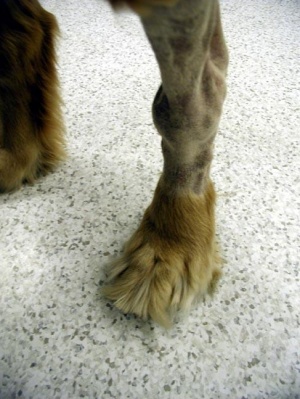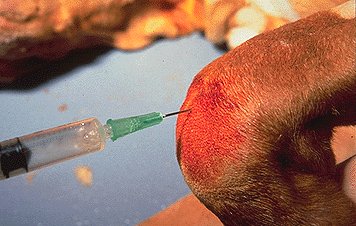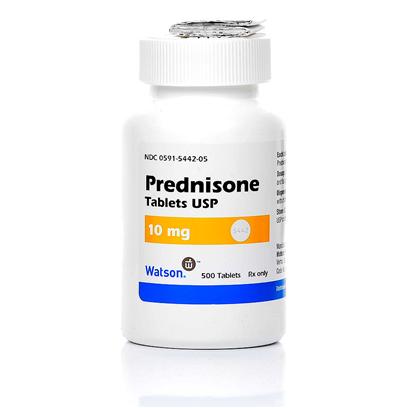My favorite aspect of practicing medicine is treating diseases caused by dysfunction of the immune system. In previous blogs, I reviewed two common immune-mediated diseases – immune-mediated hemolytic anemia and immune-mediated thrombocytopenia. A less commonly appreciated condition of immune system dysfunction is immune-mediated polyarthropathy or IMPA, a disease where the immune system attacks a pet’s joints. This week I spend some time reviewing IMPA so pet parents know about this disease. Happy reading!
Immune Mediated Polyarthropathy – What is it?
Immune-mediated polyarthropathy, also known as idiopathic, non-erosive, non-infectious arthritis, is the most common immune-mediated joint disease in dogs. This disease can also affect cats, but is much less commonly reported in this species. The hallmark feature of IMPA is joint inflammation, typically in more than one location. Essentially for any number of reasons, the immune system decides to throw a temper tantrum, taking it out on the joints to cause marked inflammation and profound discomfort.
There are four types of IMPA:
- Type I – this form is called idiopathic or primary immune related
- Type II – this form is associated with an infection somewhere in the body
- Type III – this form is associated with gastrointestinal or liver disease
- Type IV – this form is associated with cancer
Type I IMPA is the most common form of this disease. However, to label a disease as idiopathic, one must first rule out all other potential causes through a series of logical diagnostic tests.
Immune Mediated Polyarthropathy – What are the clinical signs?
Immune-mediated polyarthropathy is most commonly identified in adult (1-6 years of age) pure-breed dogs. However, there is no breed or sex predilection. Families often report the following clinical signs:
- Loss of appetite (anorexia)
- Fever
- Visibly swollen joints, particularly the carpi (wrists) and tarsi (hocks or ankles)

- Generalized stiffness
- Lameness that often shifts from leg to leg
- Increased irritability
- Enlarged peripheral lymph nodes
Immune Mediated Polyarthropathy – How is it diagnosed?
Several non-invasive tests are essential to accurately diagnose patients with IMPA, including those that:
- Evaluate joint (synovial) fluid to confirm joint inflammation and rule out a bacterial joint infection – a joint tap (arthrocentesis) with cell evaluation (cytology) and culture

- Image the affected joints to look for evidence of bone deformity and destruction – radiographs/x-rays of joints
- Measure red blood cells, white blood cells and platelets (cells that help with blood clotting) – complete blood count, peripheral blood film evaluation
- Evaluate major organ function like the liver and kidneys – biochemical profile & urinalysis
- Assess the immune system – antinuclear autoantibody (ANA) and rheumatoid factor (RF) measurement
- Look for certain infectious diseases, such as those transmitted by ticks – polymerase chain reaction (PCR) or antibody/serology tests
- Screen for cancer – chest radiographs/x-rays, abdominal radiographs +/- abdominal ultrasound
Some patients with IMPA require some unique tests depending on their history and physical examinations. For example, certain muscle studies (e.g.: electromyography, muscle biopsy) and evaluation of cerebrospinal fluid (CSF) may be indicated. Early partnering with a board-certified veterinary internal medicine specialist can be instrumental in helping formulate an efficient and cost-effective diagnostic plan.
Immune Mediated Polyarthropathy – How is it treated?
Effective treatment of IMPA requires the following:
- Identification and proper management of any predisposing disease
- Modification of how the immune system responds to inflammation
- Aggressive pain management
The initial treatment most commonly used to modulate the immune system is a steroid called prednisone; side effects are common but temporary, and may include:
- Increased thirst (polydipsia)
- Increased appetite (polyphagia)
- Increased frequency of urination (polyuria)
- Panting
- Muscle weakness
- Weight gain

Some patients with IMPA can be successfully managed with prednisone alone. However, in my experience, most benefit from the use of more than one immunosuppressive drug. No study has yet identified the ideal immunomodulatory protocol, one that works for every patient. To help develop the best possible treatment plan for your pet, consulting with a board-certified internal medicine can be invaluable. Some drugs that may be recommended (or at least discussed) include:
- Leflunomide
- Cyclosporine
- Azathioprine
- Mycophenolate mofetil
If a pet has an infection, it must be appropriately treated because inhibiting the immune system’s ability to fight such an infection could allow the infection to (rapidly) spread.
Patients living with IMPA are initially very uncomfortable! Their joints hurt, and they need aggressive pain medication. Thankfully we have a lot of drugs that may be used to help keep these fur babies as comfortable as possible. One important point about which pet parents should know is that patients receiving steroids must not concurrently receive drugs that are called non-steroid anti-inflammatory drugs or NSAIDs. Common examples of NSAIDs in veterinary medicine include:
- Carprofen (Rimadyl™)
- Deracoxib (Deramaxx™)
- Firocoxib (Previcox™)
- Meloxicam (Metacam™)
Concurrent administration of a steroid (e.g. prednisone, dexamethasone) and an NSAID can lead to liver damage, acute kidney injury (AKI), and/or gastrointestinal distress (e.g.: vomiting, diarrhea, hemorrhage, and perforation of the gastrointestinal tract). To learn about this topic, please click here.
The take-away message about immune mediated polyarthropathy…
Although the immune system unquestionably plays a pivotal role in how the body responds to inflammation and infection, dysfunction of this system can be quite problematic. Immune-mediated polyarthropathy or IMPA is one special form of immune system dysfunction characterized by an attack of immune cells on various joints in the body. With a thorough diagnostic investigation and appropriate intervention, patients living with IMPA can be effectively treated to allow them to lead relatively normal and comfortable lifestyles.
To find a board-certified veterinary internal medicine specialist, please visit the American College of Veterinary Internal Medicine.
Wishing you wet-nosed kisses,
cgb




